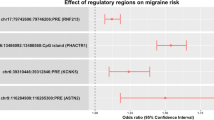Abstract
Migraine is a common neurological disease of two main types: migraine with aura and migraine without aura. Familial clustering suggests that genetic factors are involved in the etiology of migraine. Recently, a gene for familial hemiplegic migraine, a rare autosomal dominant subtype of migraine with aura, was mapped to chromosome 19p13. We tested the involvement of this chromosomal region in 28 unrelated families with the common forms of migraine with and without aura, by following the transmission of the highly informative marker D19S394. Sibpair analysis showed that affected sibs shared the same marker allele more frequently than expected by chance. Our findings thus also suggest the involvement of a gene on 19p13 in the etiology of the common forms of migraine.
Similar content being viewed by others
References
Ad Hoc Committee on Classification of Headache (1962) Classification of headache. J Am Med Assoc 179:717–718
Allan W (1928) The inheritance of migraine. Arch Intern Med 13:590–599
Baier WK (1985) Genetics of migraine and migraine accompagnée: a study of eighty-one children and their families. Neuropediatrics 16:84–91
Barolin GS, Sperlich D (1969) Migränefamilien. Beitrag zum genetischen Aspekt des Migräneleidens. Forschr Neurol Psychiatr 37:521–544
Dalsgaard-Nielsen T (1965) Migraine and heredity. Acta Neurol Scand 41:287–300
D'Amico D, Leone M, Macciardi F, Valentini S, Bussone G (1991) Genetic transmission of migraine without aura: a study of 68 families. Ital J Neurol Sci 12:581–584
Devoto M, Lozito A, Staffa G, D'Alessandro R, Sacquegna T, Romeo G (1986) Segregation analysis of migraine in 128 families. Cephalalgia 6:101–105
Goodell H, Lewontin R, Wolff HG (1954) Familial occurrence of migraine headache. A study of heredity. AMA Arch Neurol Psychiatry 72:325–334
Haan J, Terwindt GM, Bos PLJM, Ophoff RA, Frants RR, Ferrari MD (1994) Familial hemiplegic migraine in the Netherlands. Clin Neurol Neurosurg 96:244–249
Headache Classification Committee of the International Headache Society (1988) Classification and diagnostic criteria for headache disorders, cranial neuralgias and facial pain. Cephalalgia 8(suppl 7):1–97
Hovatta I, Kallela M, Färkkilä M, Peltonen L (1994) Familial migraine: exclusion of the susceptibility gene from the reported locus of familial hemiplegic migraine on 19p. Genomics 23:707–709
Joutel A, Bousser MG, Biousse V, Labauge P, Chabriat H, Nibbio A, Maciazek J, Meyer B, Bach MA, Weissenbach J, Lathrop GM, Tournier-Lasserve E (1993) A gene for familial hemiplegic migraine maps to chromosome 19. Nature Genet 5:40–45
Lathrop GM, Lalouel JM, Julier C, Ott J (1985) Multilocus linkage analysis in humans: detections of linkage and estimation of recombination. Am J Hum Genet 5:40–45
Lucas RN (1977) Migraine in twins. J Psychiatr Res 20:147–156
Miller SA, Dykes DD, Polesky HF (1988) A simple salting out procedure for extracting DNA from nucleated cells. Nucleic Acids Res 16:1215
Mochi M, Sangiorgi S, Cortelli P, Carelli V, Scapoli C, Crisci M, Monari L, Pierangeli G, Montagna P (1993) Testing models for genetic determination in migraine. Cephalalgia 13:389
Ophoff RA, Eijk R van, Sandkuijl LA, Terwindt GM, Grubben CPM, Haan J, Lindhout D, Ferrari MD, Frants RR (1994) Genetic heterogeneity of familial hemiplegic migraine. Genomics 22:21–26
Rasmussen BK, Jensen R, Schroll M, Olesen J (1991) Epidemiology of headache in a general population — a prevalence study. J Clin Epidemiol 44:1147–1157
Russell MB, Hilden J, Sorensen SA, Olesen J (1993) Familial occurrence of migraine without aura and migraine with aura. Neurology 43:1369–1373
Sandkuijl LA (1989) Analysis of affected sib pairs using information from extended families. In: Elston RC, Spence MA, Hogde SE, MacCluer JW (eds) Multipoint mapping and linkage based upon affected pedigree members: genetic analysis workshop 6. Liss, New York, pp 117–122
Suarez BK, Hodge SE (1979) A simple method for detecting linkage for rare recessive diseases: an application to juvenile diabetes. Clin Genet 15:126–136
Ziegler DK, Hassanein RS, Harris D, Stewart R (1975) Headache in a non-clinic twin population. Headache 4:213–218
Author information
Authors and Affiliations
Rights and permissions
About this article
Cite this article
May, A., Ophoff, R.A., Terwindt, G.M. et al. Familial hemiplegic migraine locus on 19p13 is involved in the common forms of migraine with and without aura. Hum Genet 96, 604–608 (1995). https://doi.org/10.1007/BF00197420
Received:
Issue Date:
DOI: https://doi.org/10.1007/BF00197420




